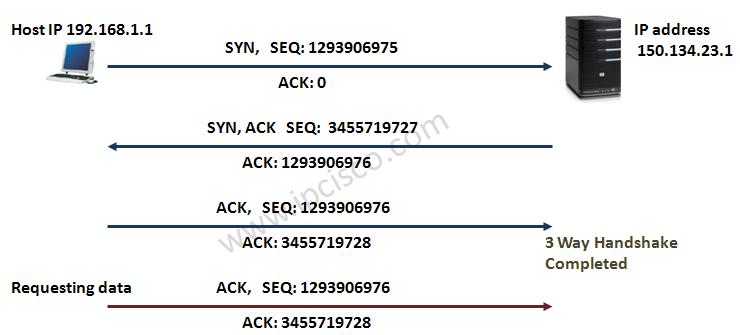- COURSES
- SPECIALS
- BLOG
- MEMBERS
- SHOP
- ABOUT
- ENROLL HERE

Table of Contents
TCP Sequence Number and TCP Acknowledgement fields are another important fields in TCP Header. Each of these TCP Header Fields are 32 bits long. Below, you can see an example TCP Header to check these fields.

These fields are in the features that make TCP, connection oriented. With tcp sequence number and acknowledgement numbers, packet reaches to the destination without any lost. If any of the packet do not reach to the destination, it is known by its sequence number and requested again. This results no lost during the session. And this makes TCP, a reliable transport protocol. At this point, UDP (Ser Datagram Protocol) is not a reliable protocol. You can compare TCP and UDP and learn the key differences of these two protocols.
Before data transfer, a new TCP connection is created. The host’s first sequence number that is used during starting of the connection is called Initial Sequence Number (ISN).
From the point of security, this is open to the hijacking attacks. It is easy for an hacker to hijack the system. Different operating systems handle tcp sequence number and acknowledgement parameters differently. A hacker checks the ISN number and then determines the operating system. After that hijacking is almost completed. He predict the next sequence number and after that the destination do not understand that it is an hacker. Hacker also use flooding towards the sending host in order to be busy. You can check this scenario better with the below picture.

Let’s explain these tcp sequence number and tcp acknowledgement numbers with the below picture.

As mentioned above, firstl the TCP 3 way handshake is completed and TCP connection established. After that the data is sent. Think this example as requesting a webpage. Firstly host send a packet with SYN flag set and the sequence number (ISN number) is filled. In the second step the remote node get the apcket and reply it with its own ISN number as a sequence number, and acknowledge the packet come with requesting next one in its ACK value. Be careful, there are two ACK here. One is 3 way handsake ACK and the other is acknowledgement number. One is flag and the other is number.
In the third step, host send the next packet with the next sequence number that remote node has wanted.And it also acknowledge the correct receivement of the packet and request the next one. After this packet received by the remote host, 3 way handshake is completed.
After 3 way handshake completed, host send the data packet with the same sequence and acknowledgement numbers. Because the ACK packet do not change the sequence and acknowledgement number values.
TCP header lenght in TCP header is also called data offset in some sniffers. It is a 4-bit long field in TCP header. It represents the TCP header length as you can understand from its name.
